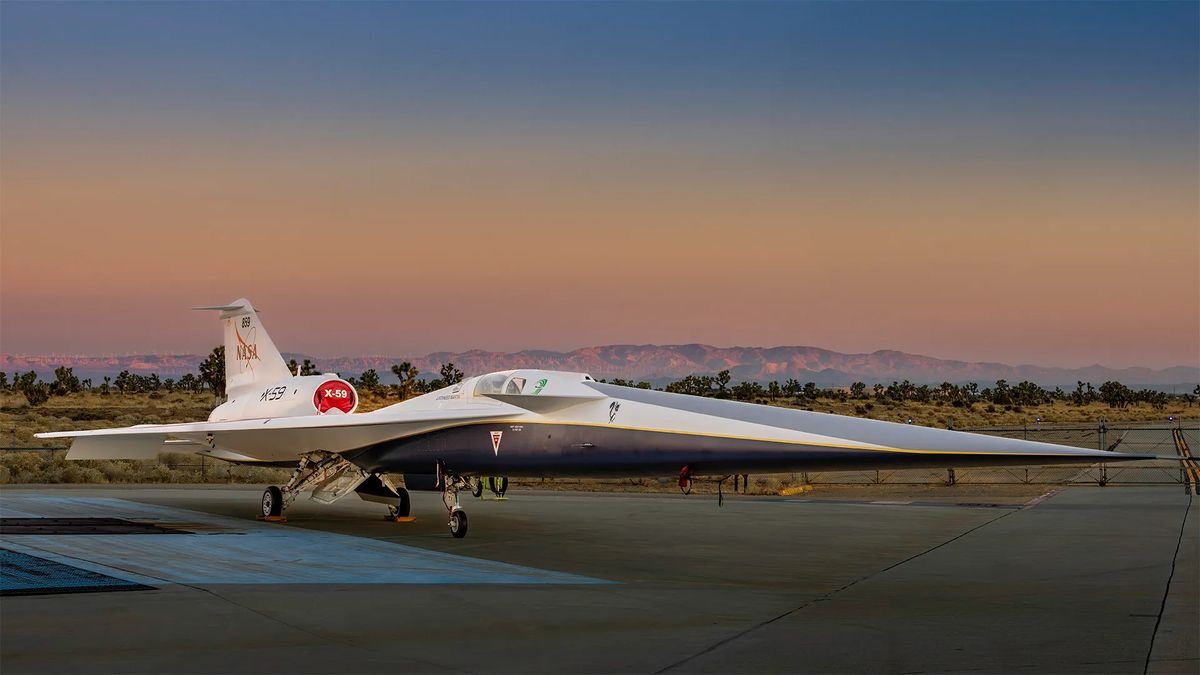If you’ve recently experienced a sonic boom, chances are it left a lasting impression. The explosive noise, caused by an aircraft exceeding the speed of sound, can be startling, even causing windows to crack. Sonic booms have been a limiting factor for supersonic passenger planes, leading to restrictions on their operations, as witnessed with the Concorde, which faced limitations on flying at supersonic speeds over land or near coastlines.
NASA is now aiming to revolutionize these regulations with its Quiet Supersonic Technology (Quesst) program, introducing a new era of quieter supersonic aircraft. At the forefront of this initiative is the X-59, a cutting-edge aircraft designed to transform the disruptive sonic boom into a gentler “thump.” NASA believes this breakthrough will pave the way for a new generation of supersonic planes that can operate more freely over land without causing disturbances.
The X-59, built by Lockheed Martin Skunk Works under a $247.5 million NASA contract, is the latest addition to a lineage of experimental planes that includes the X-1 and X-15. With a sleek design and unique features, the X-59 aims to mitigate the impact of sonic booms, making supersonic travel more acceptable to communities.
The aircraft, measuring almost 100 feet in length with a wingspan of about 29 feet, boasts a distinctive nose that accounts for approximately a third of its length. This design plays a crucial role in reducing the intensity of sonic booms. The goal is for the X-59 to produce a mere 75 decibels of sound during supersonic flight, a significant improvement compared to the Concorde’s 105 decibels.
Traditional sonic booms occur when an aircraft traveling at supersonic speeds leaves its own sound behind, creating a compressed shockwave that produces a loud boom upon meeting the human ear. The X-59’s innovative shape is intended to prevent these shockwaves from coalescing, spreading them out with the help of strategically placed aerodynamic surfaces. Additionally, the lone engine is positioned at the top of the plane to maintain a smooth lower profile and prevent shockwaves from reaching the ground.
NASA anticipates that the X-59 will fly at 1.4 times the speed of sound, or 925 mph. The Quesst program will conduct several flight tests at Lockheed Martin Skunk Works before transferring the aircraft to NASA’s Armstrong Flight Research Center in Edwards, California, for further testing.
A pivotal aspect of the program will commence in 2024 when a series of test flights will be carried out over various U.S. residential communities to gauge public response to the aircraft’s noise. This approach, reminiscent of a 1964 Federal Aviation Administration experiment, aims to avoid the issues faced when sonic booms were tested over Oklahoma City.
The data collected from these tests will be crucial in presenting findings to the U.S. Federal Aviation Administration and international regulators, potentially leading to a change in regulations for supersonic travel. NASA envisions that a successful program will usher in a new era of supersonic travel, allowing faster routes over land and significantly reducing flight times.
While the X-59 serves as a technology demonstrator rather than a prototype for commercial use, its findings are expected to inform the design of future supersonic passenger aircraft. Various companies, including Hermeus, Boom, and Spike, are actively developing supersonic passenger planes, but the insights gained from the Quesst program may influence the next generation of these high-speed aircraft.
Craig Nickol, a senior adviser at NASA Headquarters, envisions a democratization of supersonic travel, making it accessible to the general public. With the potential to revolutionize high-speed travel, NASA’s Quesst program aims to redefine the skies and overcome the limitations that have hindered the progress of supersonic aviation for decades.
Book Paris Trip
Paris sightseeing
Book Paris activities
Louvre museum paris
Paris limousine rental
Rolls Royce Paris
Eiffel Tower Paris
Airport Transfer Paris
Book Paris Taxi
Seine River Cruise
Wine Tasting Paris
Paris luxury hotels
Switzerland luxury hotels
Europe Car rental
Europe coach rental
Paris Limousine
Dior Paris
Beauvais Airport transfer
